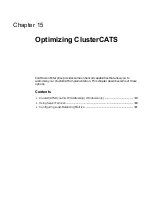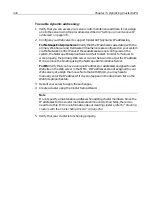
Configuring Load-Balancing Metrics
341
Configuring Load-Balancing Metrics
ColdFusion Enterprise provides you the option of customizing the load balancing
metrics of Web servers clustered with Allaire ClusterCATS software. This section
describes how to customize the metrics to your specific Web site implementation.
Overview of metrics
The ColdFusion server records the time each JSP page and servlet request takes to be
processed and can return metrics derived from this timing data upon request. These
metrics are:
•
Average Request Time
This metric reflects the average processing time of all
requests that fall within a one-minute moving window. The use of an average
smooths the affects of brief spikes in request volume and in a mixture of short-
and long-running requests.
•
Last Request Time
This metric reflects the time it took to process the last
request to the server. Because it is a single, undiluted snapshot of request time, it
will immediately reflect peaks and troughs in request processing time.
For these time-based metrics to be translated into a single load value for the Web
server, they must be weighed against a more subjective measure of server
performance—a maximum acceptable response time. This maximum reflects the
upper threshold of performance at which a server should be declared "busy" for
load-balancing purposes. Once a server reaches this critical busy threshold, the
ClusterCATS software will redirect further service requests away from the server until
it becomes more responsive to its clients.
A further enhancement in load-balancing options is provided by the ClusterCATS
software. A ClusterCATS agent process performs a probe of a special JSP page
—
getsimpleload.jsp
(every five seconds)—and records the round-trip time (RTT)
for each request. From this data, it computes its own average RTT over a one-minute
moving window.
This external view of request time accounts for the processing time of the JSP page
request itself, but, more importantly, for other system overhead involved in reaching
the Web server and receiving an acceptable response back again. By factoring in
external influences on Web server responsiveness—such as network load, scheduling
load, and disk I/O load—the ClusterCATS probe agent can adjust the load reported
by the ColdFusion engine to create a more realistic picture overall of the Web server's
performance for its clients.
For example, if the ColdFusion server is reporting a light load of requests, but the
probe agent is seeing significant round-trip times to and from the Web server, then it
will report a proportionally higher load for server and ColdFusion reported.
Summary of Contents for COLDFUSION 5-ADVANCED ADMINISTRATION
Page 1: ...Macromedia Incorporated Advanced ColdFusion Administration ColdFusion 5...
Page 20: ......
Page 56: ...38 Chapter 1 Advanced Data Source Management...
Page 74: ...56 Chapter 2 Administrator Tools...
Page 76: ......
Page 86: ...68 Chapter 3 ColdFusion Security...
Page 87: ...To Learn More About Security 69...
Page 88: ...70 Chapter 3 ColdFusion Security...
Page 130: ...112 Chapter 5 Configuring Advanced Security...
Page 132: ......
Page 154: ...136 Chapter 6 Configuring Verity K2 Server...
Page 162: ...144 Chapter 7 Indexing XML Documents...
Page 202: ...184 Chapter 8 Verity Spider...
Page 236: ...218 Chapter 10 Verity Troubleshooting Utilities...
Page 238: ......
Page 348: ...330 Chapter 14 ClusterCATS Utilities...
Page 349: ...Using sniff 331...
Page 350: ...332 Chapter 14 ClusterCATS Utilities...
Page 362: ...344 Chapter 15 Optimizing ClusterCATS...
Page 372: ...354 Index...














































